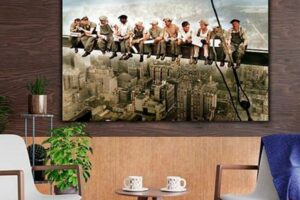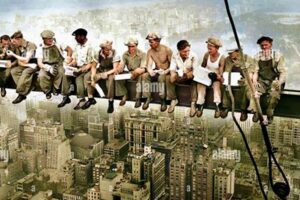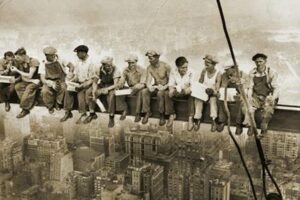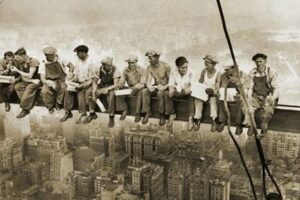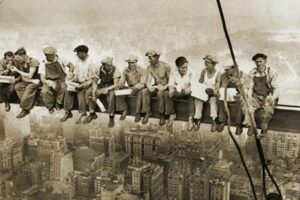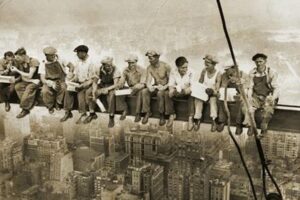“Lunch atop a skyscraper” refers to a famous black-and-white photograph taken in 1932 during the construction of the RCA Building in New York City. The image depicts eleven ironworkers sitting on a steel beam, eating lunch hundreds of feet above the ground. The photograph has become an iconic image of American history and a symbol of the bravery and skill of the workers who built the country’s skyscrapers.
The photograph was taken by Charles C. Ebbets, a photographer for the Bethlehem Steel Corporation. Ebbets was tasked with taking promotional photos of the construction of the RCA Building, and he staged the “Lunch atop a skyscraper” photo to create a dramatic and memorable image. The photo was first published in the New York Herald Tribune on October 2, 1932, and it quickly became one of the most famous and widely reproduced images in the world.
The “Lunch atop a skyscraper” photo has been the subject of much debate and speculation over the years. Some people have claimed that the photo is fake, or that the workers were not actually eating lunch. However, most experts believe that the photo is genuine, and that it accurately depicts the working conditions of ironworkers in the early 20th century.
1. Height
In the iconic “Lunch atop a Skyscraper” photograph, the workers’ elevation hundreds of feet above the ground is a crucial element that underscores their fearlessness and the inherent danger of their profession. The dizzying height at which they casually eat their lunch highlights their nerves of steel and unwavering trust in their skills.
The construction of skyscrapers during this era involved ascending to great heights on skeletal steel frames, with minimal safety measures. These workers possessed exceptional courage and agility, expertly navigating narrow beams and precarious heights. Their ability to perform their duties at such elevations, with the city as their backdrop, speaks volumes about their exceptionalism.
The photograph captures a moment of respite amidst the perilous work, yet the height at which they are perched serves as a constant reminder of the risks involved. It emphasizes the extraordinary nature of their occupation and the bravery required to build some of the world’s tallest structures.
Understanding the significance of height in this context enhances our appreciation for the skill, daring, and determination of these ironworkers. It not only adds to the dramatic impact of the photograph but also serves as a testament to the human spirit’s ability to conquer fear and achieve remarkable feats of engineering.
2. Danger
In the context of the “Lunch atop a Skyscraper” photograph, the inherent danger of the construction work serves as a crucial element that underscores the workers’ remarkable courage. The photograph captures a moment of casual camaraderie during lunchtime, yet the towering height and precarious setting serve as constant reminders of the perilous conditions under which these men labored.
The construction of skyscrapers in the early 20th century involved ascending to dizzying heights on skeletal steel frames, with minimal safety measures. The workers in the photograph, perched hundreds of feet above the ground, epitomize the courage and resilience required to perform such dangerous work. Their nonchalant demeanor, as they casually eat their lunch, belies the inherent risks involved in their profession.
The “Lunch atop a Skyscraper” photograph has become an iconic representation of the bravery and skill of ironworkers. It highlights the extraordinary measures these workers took to build some of the world’s tallest structures, often with little regard for their own safety. Their courage and determination in the face of danger serve as an inspiration, reminding us of the human capacity to overcome adversity and achieve remarkable feats of engineering.
Understanding the significance of danger in the “Lunch atop a Skyscraper” photograph provides a deeper appreciation for the workers’ courage and the challenges they faced. It also serves as a reminder of the importance of workplace safety and the ongoing efforts to ensure that all workers can perform their duties in a safe and healthy environment.
3. Lunch break
In the iconic “Lunch atop a Skyscraper” photograph, the depicted lunch break serves as a poignant reminder of the arduous work and challenging conditions these ironworkers faced. This seemingly mundane occurrence takes on a profound significance when examined within the context of their perilous profession.
- Height and Physical Exertion
The extreme heights at which these workers labored demanded immense physical exertion. Their lunch break provided a much-needed respite from the strenuous tasks of hoisting heavy beams and navigating narrow steel girders. This break allowed them to replenish their energy and prepare for the challenges that lay ahead.
- Mental and Emotional Strain
Beyond the physical demands, the construction of skyscrapers also took a significant toll on the workers’ mental and emotional well-being. The constant exposure to danger, coupled with the relentless pace of work, could lead to anxiety, stress, and exhaustion. Their lunch break offered a brief sanctuary, a moment to decompress and gather their thoughts before returning to their hazardous tasks.
- Camaraderie and Support
The lunch break also served as an essential opportunity for the workers to socialize and build camaraderie. Perched high above the city, they shared stories, jokes, and laughter, forging bonds that transcended their workplace. This camaraderie provided a sense of support and resilience, enabling them to face the challenges of their work together.
- Appreciation for Life
The juxtaposition of their perilous workplace and the casual nature of their lunch break highlights the workers’ appreciation for life. Their ability to find moments of respite and joy amidst such danger speaks to their resilience and their determination to make the most of every moment.
In conclusion, the lunch break depicted in the “Lunch atop a Skyscraper” photograph offers a multi-faceted glimpse into the lives of these remarkable ironworkers. It showcases their physical and mental endurance, their camaraderie and resilience, and their ability to find moments of joy and respite even in the face of great danger.
4. Ironworkers
The iconic “Lunch atop a Skyscraper” photograph serves as a testament to the extraordinary skill and strength of ironworkers, the specialized workers responsible for constructing some of the world’s tallest structures. Their expertise and unwavering determination are integral components of the image’s enduring legacy and cultural significance.
Ironworkers possess a unique combination of physical prowess, technical expertise, and unwavering courage. Their ability to navigate dizzying heights, handle heavy materials, and work with precision in precarious conditions is truly remarkable. The “Lunch atop a Skyscraper” photograph captures this essence, showcasing ironworkers casually eating lunch hundreds of feet above the ground, their faces etched with a sense of accomplishment and camaraderie.
The photograph highlights the indispensable role of ironworkers in shaping the skylines of cities around the world. Their skill and strength have enabled the construction of towering skyscrapers, bridges, and other architectural marvels that define modern society. Without their expertise, these structures would simply not exist, and our cities would lack their iconic landmarks.
Understanding the significance of ironworkers in the context of the “Lunch atop a Skyscraper” photograph enhances our appreciation for the skill, courage, and determination required in their profession. It also serves as a reminder of the importance of recognizing and celebrating the contributions of specialized workers in various fields, whose expertise and dedication shape our world in countless ways.
5. New York City
The iconic “Lunch atop a Skyscraper” photograph has become inextricably linked with New York City, serving as a visual representation of the city’s architectural prowess and its status as a global metropolis. This connection is multifaceted and deeply rooted in the photograph’s history, symbolism, and cultural impact.
- Historical Significance
The photograph was taken during the construction of the RCA Building in Rockefeller Center, a pivotal moment in New York City’s architectural history. The image captured the daring spirit and innovative techniques employed in the construction of some of the world’s tallest skyscrapers, forever associating the city with architectural advancements.
- Symbol of Progress
The “Lunch atop a Skyscraper” photograph has become a symbol of New York City’s relentless pursuit of progress and its ever-evolving skyline. The towering skyscrapers depicted in the image represent the city’s ambition, determination, and its ability to push the boundaries of architectural design.
- Cultural Icon
The photograph has transcended its historical context to become a cultural icon, deeply embedded in the collective consciousness of New York City and beyond. Its widespread reproduction in popular culture, from posters to postcards, has further cemented its association with the city, making it an instantly recognizable symbol of New York’s architectural legacy.
- Tourist Destination
The location of the “Lunch atop a Skyscraper” photograph, 30 Rockefeller Plaza, has become a popular tourist destination for visitors from around the world. The Top of the Rock observation deck offers breathtaking views of the city, allowing visitors to experience the same awe-inspiring vista as the ironworkers captured in the iconic image.
In conclusion, the connection between “New York City: The image is synonymous with the city’s architectural achievements” and “lunch atop a skyscraper puzzle” is deeply rooted in the photograph’s historical significance, its symbolism of progress, its status as a cultural icon, and its enduring legacy as a tourist destination. The photograph has become an integral part of New York City’s identity, showcasing the city’s architectural prowess and its unwavering pursuit of innovation.
6. 1932
The iconic “Lunch atop a Skyscraper” photograph captures the spirit of resilience and determination that prevailed during the Great Depression, a period of economic hardship and widespread unemployment. This connection adds a deeper layer of significance to the image, highlighting the strength and perseverance of the human spirit in the face of adversity.
- Economic Context
The Great Depression was a global economic crisis that began in 1929 and lasted throughout the 1930s. It led to widespread unemployment, poverty, and social unrest. The construction of the RCA Building, where the “Lunch atop a Skyscraper” photograph was taken, provided much-needed employment opportunities during this challenging time.
- Symbol of Hope
The photograph became a symbol of hope and resilience during the Great Depression. It depicted workers high above the city, taking a break from their arduous labor to enjoy a simple lunch. This image provided a glimmer of hope and inspiration to those struggling during this difficult period.
- Tribute to Workers
The “Lunch atop a Skyscraper” photograph serves as a tribute to the resilience and determination of workers. It captures the strength and courage of those who continued to work hard despite the economic challenges of the time. The image reminds us of the importance of perseverance and the dignity of labor.
- Legacy of the Great Depression
The photograph remains a powerful reminder of the Great Depression and its impact on the lives of ordinary people. It serves as a historical document that sheds light on the challenges and triumphs of this era. By examining the photograph in the context of the Great Depression, we gain a deeper understanding of its historical significance and its relevance to contemporary issues related to labor and economic hardship.
In conclusion, the connection between “1932: The photograph was captured during the Great Depression, highlighting the resilience of workers” and “lunch atop a skyscraper puzzle” adds a profound dimension to the image. It emphasizes the strength and determination of the human spirit, particularly during challenging economic times. The photograph serves as a timeless tribute to the resilience of workers and a reminder of the importance of perseverance in the face of adversity.
7. Black-and-white
The iconic “Lunch atop a Skyscraper” photograph is rendered in striking black-and-white, a choice that contributes significantly to its enduring appeal and iconic status. The absence of color imbues the image with a timeless quality, transcending specific eras or fads, and allowing it to resonate with viewers across generations.
- Historical Context
Black-and-white photography was the dominant medium during the early 20th century when the “Lunch atop a Skyscraper” photograph was taken. This monochromatic aesthetic evokes a sense of nostalgia and authenticity, connecting the image to the historical period in which it was created.
- Focus on Composition and Form
The absence of color in the “Lunch atop a Skyscraper” photograph shifts the viewer’s attention to the composition, form, and interplay of light and shadow. This allows viewers to appreciate the intricate details of the ironworkers’ poses, the interplay of vertical and horizontal lines, and the overall balance and harmony of the image.
- Emotional Impact
Black-and-white photography often conveys a sense of gravitas and emotional depth. In the “Lunch atop a Skyscraper” photograph, the monochromatic tones enhance the of the workers’ camaraderie and the inherent danger of their situation, creating a more powerful and evocative image.
- Symbolism and Abstraction
The lack of color in the “Lunch atop a Skyscraper” photograph allows it to transcend its literal depiction and become a more abstract and symbolic representation of human endeavor, ambition, and the pursuit of progress. The black-and-white tones lend themselves to multiple interpretations, inviting viewers to contemplate the deeper meanings and messages embedded within the image.
In conclusion, the black-and-white aesthetic of the “Lunch atop a Skyscraper” photograph is not merely a technical choice but an integral part of its artistic and cultural significance. The monochromatic tones contribute to the image’s timeless appeal, allowing it to transcend specific eras and connect with viewers on a deeper emotional and symbolic level.
8. Charles C. Ebbets
The iconic “Lunch atop a Skyscraper” photograph is not only a testament to the courage and resilience of the ironworkers depicted but also a reflection of the exceptional skill and artistry of the photographer, Charles C. Ebbets. His ability to capture this moment in such a compelling and enduring way has solidified his place in the annals of photographic history.
- Technical Expertise
Ebbets possessed a deep understanding of the technical aspects of photography. He carefully calculated the exposure, aperture, and shutter speed to ensure that the photograph would be properly lit and focused. His expertise allowed him to capture the details of the ironworkers’ expressions and the vast expanse of the city below.
- Artistic Vision
Beyond his technical proficiency, Ebbets also had a keen artistic eye. He recognized the potential of the scene before him and arranged the ironworkers in a dynamic and visually striking composition. The photograph’s off-center placement of the workers and the use of negative space create a sense of tension and drama.
- Historical Significance
Ebbets’ photograph has become an iconic image, not only in the realm of photography but in American history as a whole. It has been reproduced countless times in textbooks, magazines, and on websites, serving as a visual representation of the era of skyscraper construction and the spirit of American ingenuity.
- Legacy and Influence
Ebbets’ photograph has had a lasting influence on photography and beyond. It has inspired countless other photographers to capture compelling images of workers and the built environment. Its enduring popularity is a testament to the power of photography to capture and convey the essence of human experience.
In conclusion, Charles C. Ebbets’ skill in capturing the “Lunch atop a Skyscraper” moment was a confluence of technical expertise, artistic vision, and historical significance. His photograph remains a timeless masterpiece that continues to inspire and captivate audiences worldwide.
9. Symbolism
The iconic “Lunch atop a Skyscraper” photograph has transcended its historical significance to become a powerful symbol of American ingenuity and determination. This symbolism is deeply ingrained in the image’s composition, context, and cultural impact.
- American Dream and Aspiration
The photograph captures the spirit of the American dream and the relentless pursuit of progress. The ironworkers, perched high above the city, embody the ambition and determination that have shaped the nation’s history. Their casual demeanor amidst the perilous conditions symbolizes the can-do attitude and unwavering resolve that have characterized American society.
- Architectural Triumph
The “Lunch atop a Skyscraper” photograph serves as a testament to the engineering ingenuity and architectural prowess of the United States. The towering skyscrapers in the background represent the nation’s technological advancements and its ability to push the boundaries of human endeavor.
- Resilience in Adversity
The photograph has also become a symbol of American resilience in the face of adversity. Taken during the Great Depression, the image evokes the strength and determination of the American people during challenging times. The ironworkers’ ability to find moments of camaraderie and respite amidst the economic hardship underscores the indomitable spirit of the nation.
- Cultural Icon
Over the years, the “Lunch atop a Skyscraper” photograph has become deeply ingrained in American culture. It has been reproduced countless times in popular culture, from movies to advertisements, solidifying its status as an iconic representation of the American spirit.
In conclusion, the “Lunch atop a Skyscraper” photograph has become a powerful symbol of American ingenuity and determination. Its composition, context, and cultural impact have combined to create an image that embodies the nation’s aspirations, architectural achievements, resilience, and cultural identity.
Frequently Asked Questions (FAQs) about the “Lunch atop a Skyscraper” Photo
This section addresses common questions and misconceptions surrounding the iconic “Lunch atop a Skyscraper” photograph:
Question 1: Is the “Lunch atop a Skyscraper” photograph real?
Answer: Yes, the photograph is genuine. It was captured by Charles C. Ebbets on September 20, 1932, during the construction of the RCA Building in New York City.
Question 2: Who are the people in the photograph?
Answer: The eleven ironworkers depicted in the photograph have been identified as (from left to right):
- Joseph Eckner
- Joseph Scavone
- Michael Fogarty (possibly)
- Patrick Glynn
- Joe Curtis
- Alphonse Maynard
- Bill Jones
- Gus Thomas
- Walter Walker
- Sonny Glynn
- Ed Hynes
Question 3: Were the ironworkers actually eating lunch?
Answer: Yes, the ironworkers were having lunch during the photoshoot. They had been working on the 69th floor of the RCA Building when they took a break at around 10:20 am to eat their sandwiches and coffee.
Question 4: How high up were the ironworkers when the photo was taken?
Answer: The photograph was taken approximately 850 feet (260 meters) above the ground, on the 69th floor of the RCA Building.
Question 5: Is the “Lunch atop a Skyscraper” photograph dangerous?
Answer: Yes, the photograph captures a moment of genuine danger. The ironworkers were sitting on a narrow steel beam, hundreds of feet above the ground, with no safety harnesses or other protective gear.
Question 6: What is the significance of the “Lunch atop a Skyscraper” photograph?
Answer: The “Lunch atop a Skyscraper” photograph is an iconic image that represents the courage, skill, and determination of the ironworkers who built America’s skyscrapers. It has become a symbol of American ingenuity and the pursuit of progress.
These FAQs provide a deeper understanding of the historical and cultural significance of the “Lunch atop a Skyscraper” photograph, dispelling common myths and misconceptions.
Transition to the next article section:
Tips for Analyzing the “Lunch atop a Skyscraper” Photograph
The iconic “Lunch atop a Skyscraper” photograph offers a wealth of insights into American history, architectural achievements, and the human spirit. To fully appreciate its significance, consider the following tips:
Tip 1: Examine the composition.
Pay attention to the arrangement of the ironworkers on the beam. Note the off-center placement, the interplay of vertical and horizontal lines, and the use of negative space. These elements contribute to the image’s dynamic and visually striking composition.
Tip 2: Analyze the symbolism.
The “Lunch atop a Skyscraper” photograph is rich in symbolism. Consider the ironworkers as representatives of American ingenuity and determination. The towering skyscrapers in the background symbolize architectural progress and ambition. The casual demeanor of the workers amidst the danger highlights their resilience and unwavering spirit.
Tip 3: Understand the historical context.
The photograph was taken during the Great Depression, a time of economic hardship and widespread unemployment. The construction of the RCA Building provided much-needed jobs, and the “Lunch atop a Skyscraper” image became a symbol of hope and perseverance during this challenging period.
Tip 4: Identify the ironworkers.
Eleven ironworkers are depicted in the photograph. Research their identities and learn about their backgrounds and experiences. This will provide a deeper understanding of the individuals behind the iconic image.
Tip 5: Consider the safety implications.
While the “Lunch atop a Skyscraper” photograph captures a moment of camaraderie, it also highlights the inherent danger of the ironworkers’ profession. Consider the lack of safety harnesses and the extreme height at which they were working. This aspect adds to the image’s dramatic impact and serves as a sobering reminder of the risks involved in skyscraper construction.
Key Takeaways:
- The “Lunch atop a Skyscraper” photograph is a multifaceted image that transcends its historical context.
- By analyzing the composition, symbolism, historical context, and safety implications, we gain a deeper appreciation for its significance.
- The photograph remains an enduring symbol of American ingenuity, architectural prowess, and the indomitable human spirit.
Conclusion
The “Lunch atop a Skyscraper” photograph has captured the imagination of generations, serving as an enduring symbol of American ingenuity, architectural prowess, and the indomitable human spirit. Through its iconic composition, rich symbolism, and historical significance, this image transcends its moment of creation to become a timeless representation of human endeavor and aspiration.
The photograph invites us to reflect on the courage, skill, and determination of those who built our cities and shaped our skylines. It reminds us of the resilience and perseverance that have defined the American experience, and inspires us to embrace challenges and pursue our dreams with unwavering resolve. The “Lunch atop a Skyscraper” photograph is not merely a historical artifact but a powerful reminder of the human capacity for greatness.


